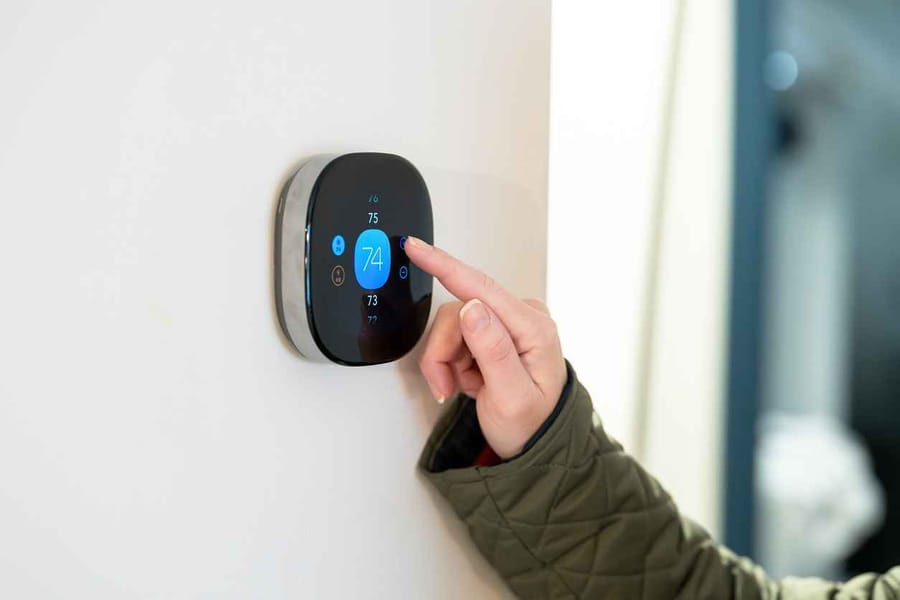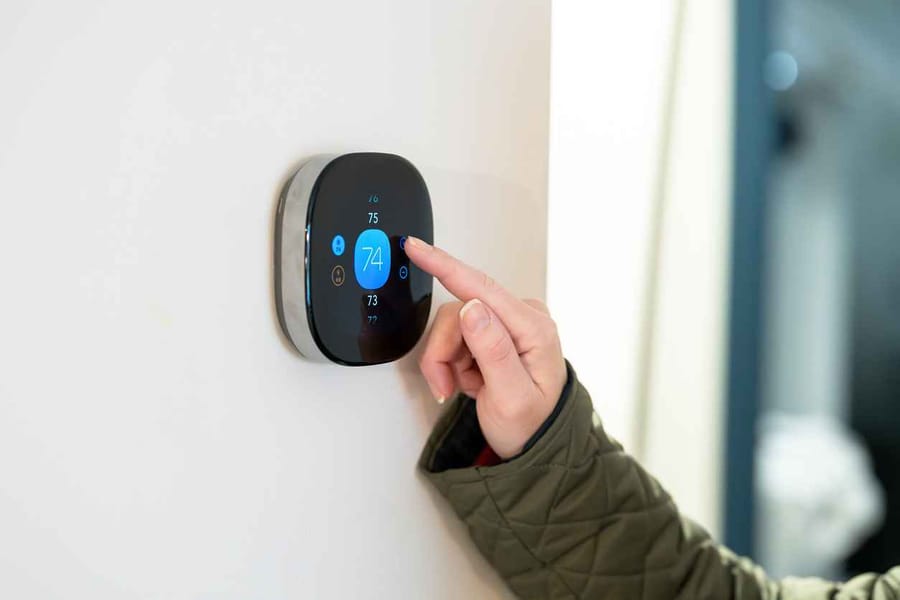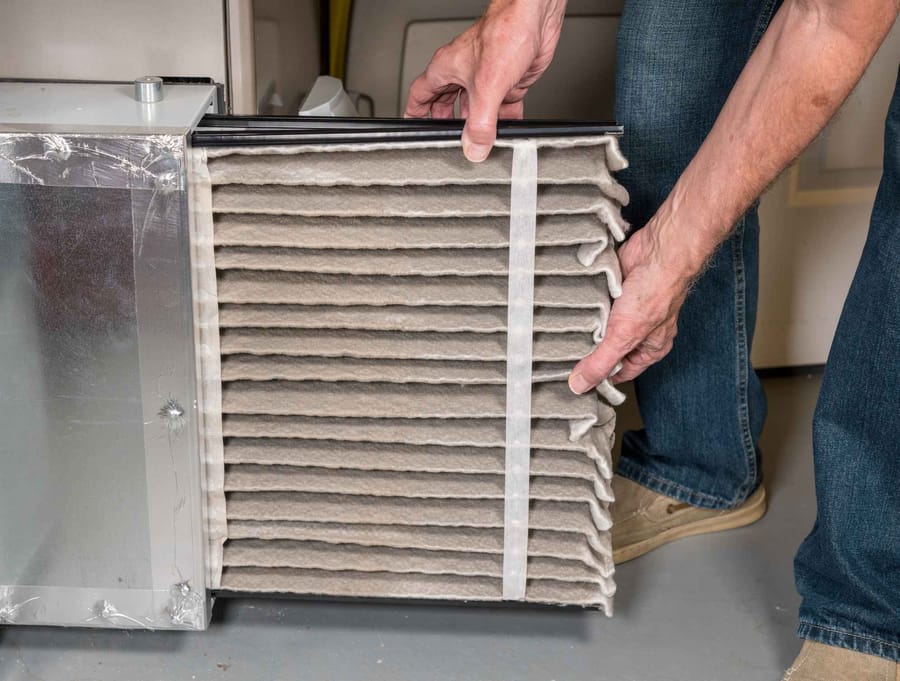4.9 Google Rating
Is Your Thermostat Costing You Money? Smart vs. Traditional Thermostats Explained

Your thermostat may seem like a small part of your home, but it plays a huge role in your monthly energy bills. In a climate like Dallas‑Fort Worth—where air conditioners work overtime for much of the year—your thermostat directly impacts how often and how hard your HVAC system runs. If you’re using an outdated or poorly programmed model, you could be spending more than necessary to keep your home comfortable. That’s why many homeowners are switching to smart thermostats, which offer enhanced control, automation, and real-time insights into your energy use. But are they truly better than traditional options?
In this blog, we’ll break down the differences between smart and traditional thermostats, explore the pros and cons of each, and help you decide which one makes the most sense for your lifestyle and your wallet.
How Thermostats Affect Energy Costs in Dallas‑Fort Worth
In Dallas‑Fort Worth, where HVAC systems often run for most of the year, your thermostat is more than just a temperature dial—it’s the command center for your home’s energy usage. When used correctly, it can help your system operate efficiently and reduce your monthly utility bills. But if it’s outdated, incorrectly set, or simply inefficient, it could be causing your HVAC system to work harder than necessary.
Traditional thermostats, especially non-programmable ones, require manual adjustment and can easily be left running while you’re away or asleep. That leads to wasted energy and unnecessary wear on your HVAC system. In contrast, newer thermostats—particularly smart models—can automatically adjust settings based on your routine, reducing energy use without sacrificing comfort.
In a region where summer heat often pushes systems to their limit, even small inefficiencies can turn into big expenses. If your thermostat isn’t helping you manage energy demand effectively, it might be time to reconsider how it’s impacting your comfort—and your wallet.
Key Differences Between Smart and Traditional Thermostats
Understanding how smart and traditional thermostats operate is the first step to deciding which one best fits your home and lifestyle. While both manage your heating and cooling system, the features they offer—and the level of control they provide—are vastly different.
Features of Traditional Thermostats
Traditional thermostats are basic devices that allow you to manually set your preferred temperature. Some models are programmable, letting you schedule changes in advance, but overall, they offer limited flexibility.
-
Basic temperature control without adaptive learning
-
Manual adjustments for each temperature change
-
Limited or no scheduling features in older models
-
No connectivity or app-based control
-
Often lack precise temperature readings
These thermostats are simple and familiar, but they require consistent monitoring and don’t offer any feedback on your energy usage.
Features of Smart Thermostats
Smart thermostats are designed to optimize your home’s comfort while reducing energy consumption. They use advanced technology to learn your behavior and adjust automatically.
-
Wi-Fi enabled, allowing control from your phone, tablet, or smart speaker
-
Learning capabilities that adjust settings based on your daily habits
-
Real-time data on energy usage, temperature trends, and system performance
-
Custom alerts for filter changes, temperature extremes, or maintenance reminders
-
Integration with smart home platforms like Alexa or Google Assistant
Smart thermostats offer not only convenience but also the potential for measurable savings on your monthly utility bills—especially important in the high-demand climate of Dallas‑Fort Worth.
Pros and Cons of Smart vs. Traditional Thermostats
Before deciding which type of thermostat is right for your home, it’s important to weigh the benefits and potential drawbacks of each option. Your HVAC efficiency, comfort, and long-term energy savings can all be influenced by this one device.
Smart Thermostat Pros and Cons
Pros:
-
Energy Savings: Smart thermostats help reduce your utility bills by optimizing heating and cooling schedules based on your habits.
-
Convenience: You can adjust temperatures remotely from your phone, whether you’re at work, on vacation, or in bed.
-
Automation: Many models learn your preferences and adjust automatically over time.
-
Real-Time Feedback: Receive alerts about maintenance, filter changes, or extreme indoor temperatures.
-
Integration: Compatible with smart home systems for added functionality and voice control.
Cons:
-
Upfront Cost: Smart thermostats are more expensive initially than traditional models.
-
Connectivity Needs: They require a reliable Wi-Fi connection to function fully.
-
Complex Setup: Some systems may need professional installation or may not be compatible with older HVAC setups.
Traditional Thermostat Pros and Cons
Pros:
-
Lower Cost: Traditional thermostats are inexpensive and readily available.
-
Simplicity: Easy to use without apps, tech, or a learning curve.
-
No Internet Required: They function independently of Wi-Fi or smart systems.
Cons:
-
Limited Features: Most models lack scheduling, remote access, and energy tracking.
-
Manual Control Only: Requires consistent user input to stay efficient.
-
Outdated Tech: May not be compatible with energy-saving goals or modern HVAC systems.
How to Decide Which Thermostat Is Right for You
Choosing between a smart or traditional thermostat depends on your household habits, comfort preferences, and long-term energy goals. The best thermostat for your Dallas‑Fort Worth home should match both your lifestyle and your HVAC system’s capabilities.
When to Stick With a Traditional Thermostat
A traditional thermostat may still be the right choice in certain situations:
-
Simple HVAC Systems: If your home uses a basic heating and cooling setup, a manual or programmable thermostat may be sufficient.
-
Fixed Daily Schedules: For homeowners with predictable routines, traditional thermostats can be programmed and left alone.
-
No Interest in Smart Tech: If you prefer hands-on control and don’t want app-based features, a traditional unit offers straightforward operation.
-
Budget Constraints: When upfront cost is a concern, traditional thermostats are more affordable.
While they may not offer automation, traditional thermostats can still be effective if used consistently and properly programmed.
When to Upgrade to a Smart Thermostat
For many modern households, smart thermostats provide clear advantages:
-
Busy or Variable Schedules: If your family’s routines change often, a smart thermostat adapts automatically to your needs.
-
Tech-Friendly Homes: Smart thermostats integrate easily with other smart home features, offering centralized control.
-
Frequent Travelers: Control your HVAC system remotely, ensuring comfort when you return without wasting energy while you’re away.
-
Energy Efficiency Goals: If you’re looking to reduce monthly bills and track usage, smart thermostats offer detailed insights and learning capabilities.
-
Multiple Zones or Larger Homes: Smart thermostats can help manage complex systems more efficiently.
In Dallas‑Fort Worth, where HVAC systems work hard most of the year, upgrading to a smart thermostat often pays for itself in energy savings and convenience.
Tips for Using Your Thermostat More Efficiently
Whether you stick with a traditional thermostat or invest in a smart model, how you use it plays a major role in your home’s energy efficiency. Smart settings and small habits can lead to big savings—especially in the extreme climate of Dallas‑Fort Worth.
-
Adjust the Temperature When You’re Away: Set your thermostat a few degrees higher in the summer and lower in the winter while you’re out of the house. Even a small change can reduce energy use.
-
Use Built-In Scheduling Features: Program your thermostat around your daily routine. Smart thermostats can automate this, but many traditional models offer scheduling as well.
-
Avoid Drastic Temperature Swings: Don’t crank the thermostat up or down to quickly heat or cool the house. This doesn’t speed up the process—it just wastes energy.
-
Use Zoned Heating and Cooling If Available: Direct airflow only to the areas in use. This reduces strain on your system and saves energy.
-
Maintain Your Thermostat: Change the batteries annually (if applicable), dust the unit regularly, and make sure it’s level and away from direct sunlight for accurate readings.
These habits, combined with regular HVAC maintenance, help ensure that your system performs efficiently and your energy dollars are well spent.
Save Money and Boost Comfort With the Right Thermostat
Your thermostat is more than a temperature setting—it’s a key factor in your home’s comfort, energy efficiency, and monthly utility costs. Whether you’re using a traditional model or considering a smart upgrade, how you manage your thermostat can significantly impact your HVAC system’s performance.
In Dallas‑Fort Worth, where your AC and heater get plenty of use throughout the year, choosing the right thermostat—and using it wisely—can lead to noticeable savings. Smart thermostats offer enhanced control, automation, and long-term energy benefits, while traditional models still provide simple, budget-friendly functionality for those with consistent routines.
If you’re ready to upgrade or just want expert guidance, Moss Heating & Cooling is here to help. Contact us today to explore the best thermostat options for your home and enjoy a more efficient, comfortable indoor environment—no matter what Texas weather throws your way.
Recent News

DFW Energy Saver Tips for Your Heating System

Why Is My Heater Blowing Cold Air? Dallas Homeowner Troubleshooting Guide
